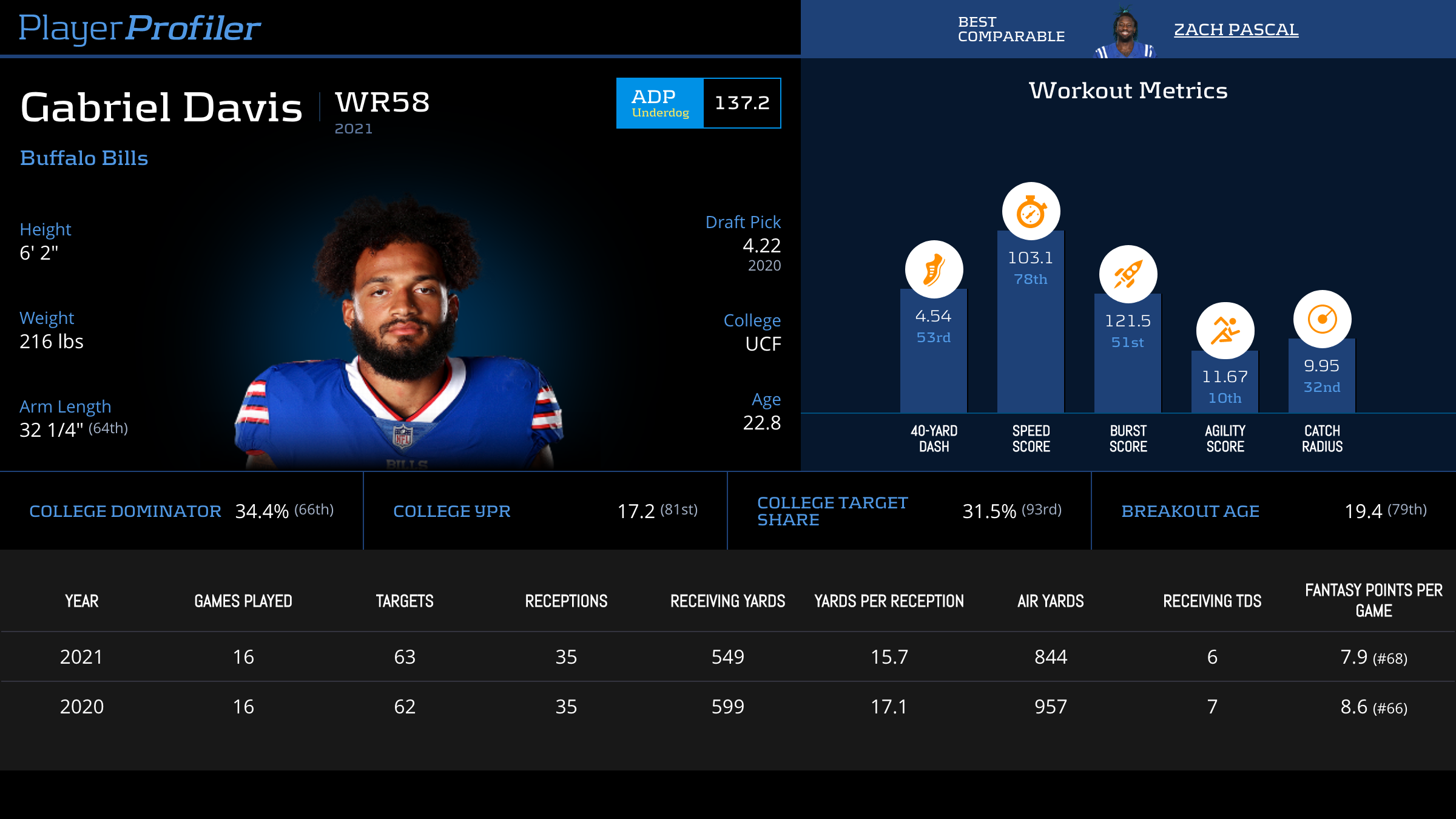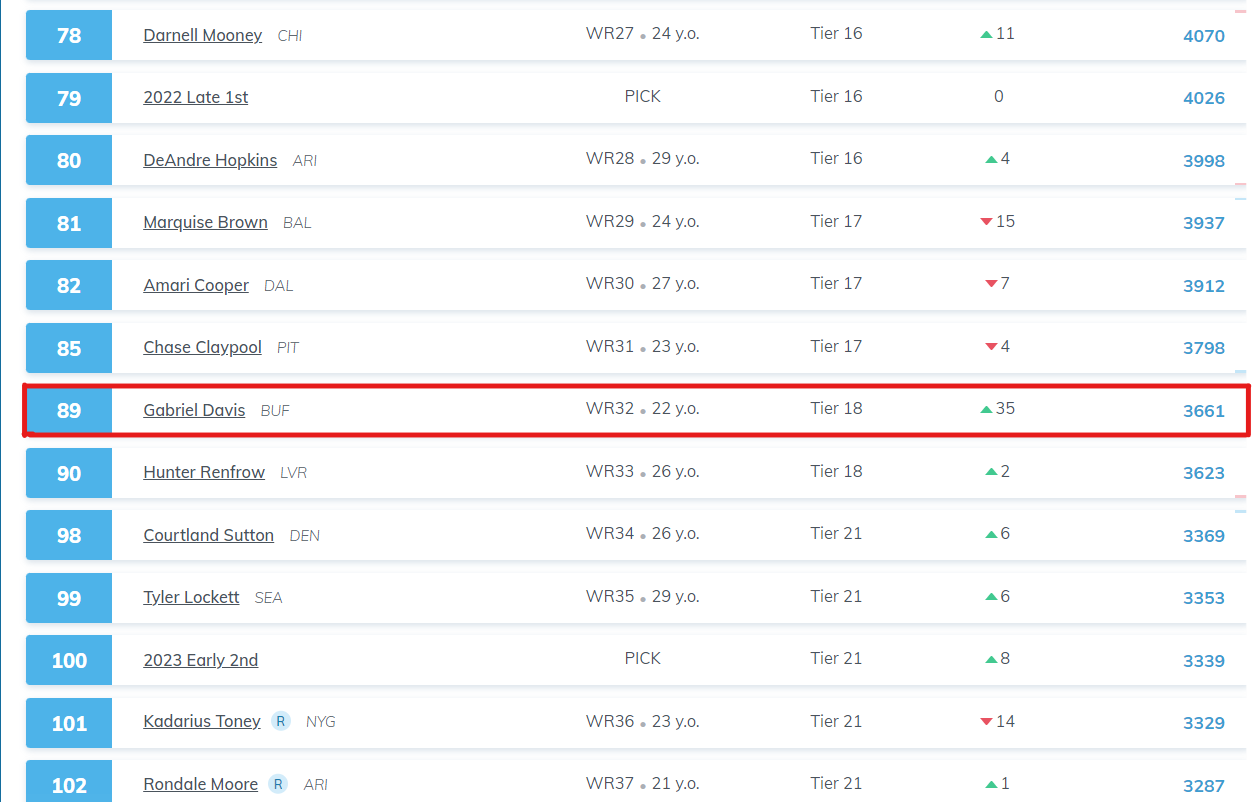Is Gabriel Davis For Real?
Bills receiver Gabriel Davis just had one of the best playoff games seen for a receiver. Davis notched eight receptions for 201 yards and four touchdowns in an epic showdown against the Chiefs. However, does this mean he’s breaking out for fantasy football? Is he worthy of his rising dynasty ranks and can he be a consistent weekly producer? Let’s dive into his profile and production.
Davis’ Profile and College Production
In college, Gabriel Davis saw above average usage at UCF, earning a 31.5-percent (94th-percentile among qualified wide receivers) College Target Share and averaging 17.2 (82nd-percentile) College Yards Per Reception. He capped off his college production with 12 touchdowns in 12 games in his last year at UCF. However, looking at Davis’ workout metrics and profile, he doesn’t scream “target hog.”
Davis ranks in the 78th-percentile for Speed Score, and in lower percentiles in all other PlayerProfiler workout metrics, including in the 9th-percentile for Agility Score. He had good speed and mediocre catch ability coming out of college, landing as a day three pick with Buffalo. He saw great college production, but his workout metrics are not that of a typical alpha that earns a large number of targets on a weekly basis.
Davis’ NFL Production and Usage
As a rookie in 2020, Gabriel Davis produced 8.6 (No. 66) Fantasy Points Per Game on a 10.9-percent (No. 93) Target Share and 12 (No. 27) Red Zone Targets. This season, his production was nearly the same. He produced 7.9 (No. 68) FPPG with another 10.9-percent (No. 90) Target Share and 17 (No. 14) Red Zone Targets. He finished with the same number of receptions as 2020, but less receiving yards and one less touchdown, leading to his lower FPPG total.
The biggest change from 2020 to 2021 for Davis was that his Snap Share and Route Participation significantly decreased. He saw more targets per route run this season, indicating he earned targets when he was on the field, but did not get starter-level routes behind Stefon Diggs, Cole Beasley, and Emmanuel Sanders.
IMO the community conflates opportunity signal from targets and routes/carries.
Volume (TGTs) is stickier at WR than RB (carries) because drawing targets – getting open – is a skill. Carries are a function of being played by your coach.
I view routes more like carries than TGTs https://t.co/ZKssBQcdfD
— Jakob Sanderson (@JakobSanderson) January 25, 2022
He was getting open on his limited Route Participation and saw a higher Red Zone Target Share than Beasley and Sanders. So, he earned usage when given routes this season, seeing at least five targets in four out of five regular season games where he ran at least 25 routes.
Davis has been a deeper threat in his career, ranking top-12 among WRs in Average Target Distance and Yards Per Reception both of his seasons in the NFL. He has also seen large red zone usage, ranking top-30 in Red Zone Targets both his seasons with 13 career touchdowns, more than Beasley and Dawson Knox the last two seasons. Davis is efficient in several advanced metrics, apart from Catch Rate and Drop Rate, both of which he ranked outside the top-75 in this season.
Ultimately, Davis is an efficient receiver who garners large chunks of yardage and touchdown opportunity when he sees the ball. However, he has not received enough opportunity to see if he can be consistent as a weekly starter. His profile and ability as a more “chunk play” receiver contributes to his lesser opportunity, as he is seldom seen as a do-it-all guy like Diggs.
What To Do with Davis?
Now, what does Gabriel Davis‘ profile and production mean for fantasy? He has shown he can produce with big plays and red zone opportunity. However, Buffalo’s receiver corps still has Stefon Diggs and Cole Beasley next season, with TE Dawson Knox. That still leaves plenty of opportunity, but enough to return value where he’s at for dynasty? He would need to be at least a WR3 (top-36) to return his current dynasty value, and to continue to have value, as a player without a top-36 finish in three seasons is unlikely to be fantasy relevant going forward. He has catapulted himself into the top-35 dynasty WRs, according to KeepTradeCut, with value similar to Chase Claypool, Hunter Renfrow, and Tyler Lockett.
Davis has only finished as a top-36 WR in nine of thirty-two career games. Counting on top-36 WR production from him means counting on a year three opportunity increase, after it decreased in year two. Players like Mecole Hardman, Allen Lazard, and Marquez Valdes-Scantling were third year players with similar prior production and situations as Davis for 2021. None of these three finished as top-45 WRs. Hunter Renfrow was a third year semi-breakout but had seen more opportunity than Davis in his first couple seasons.
Trade Gabriel Davis in dynasty📢 pic.twitter.com/UGDSCIy8Gp
— PlayerProfiler (@rotounderworld) January 26, 2022
Last Word
Davis is a big play threat with deep catch ability and high touchdown opportunity, but does not have a consistent role or usage with Buffalo. Yes, he had a breakout playoff game, but if it rockets his value to the point of productive players seeing opportunity like Renfrow, Claypool, and Lockett, it’s time to sell him in dynasty formats. He is a good flier and projects to be a productive later round pick in redraft and Best Ball formats for 2022. However, it’s unlikely that he will be a consistent every-week starter and contributor for fantasy teams down the road, he is more likely to be a guy to rotate in and out of lineups rather than a weekly lock.










